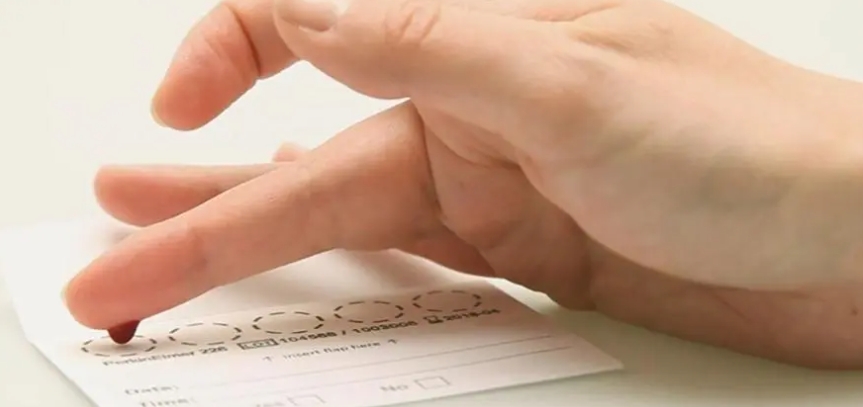Simple blood test can help diagnose bipolar disorder
通过简单的血液测试诊断双相情感障碍,可以确保患者在第一时间得到正确的治疗。
——雅各布·托马西克(Jakub Tomasik)
The ability to diagnose bipolar disorder with a simple blood test could ensure that patients get the right treatment the first time.
——Jakub Tomasik
研究人员已经开发出一种改进双相情感障碍诊断的新方法,通过简单的血液测试来识别与该疾病相关的生物标志物。
Researchers have developed a new way of improving diagnosis of bipolar disorder that uses a simple blood test to identify biomarkers associated with the condition.

为检测提供一滴血 Providing a drop of blood for a test
Credit: Cambridge Centre for Neuropsychiatric Research
剑桥大学研究人员通过在线精神评估和血液测试来诊断双相情感障碍,该疾病患者中有很多被误诊为重度抑郁症。
The researchers, from the University of Cambridge, used a combination of an online psychiatric assessment and a blood test to diagnose patients with bipolar disorder, many of whom had been misdiagnosed with major depressive disorder.
研究人员表示,单纯使用血液测试即可诊断出30%的的双相情感障碍,而如果与数字心理健康评估相结合将会更加有效。
The researchers say the blood test on its own could diagnose up to 30% of patients with bipolar disorder, but that it is even more effective when combined with a digital mental health assessment.
结合生物标志物测试可以帮助医生区分重度抑郁症和双相情感障碍。这两种疾病虽然存在重叠症状,但需要不同的药物治疗。
Incorporating biomarker testing could help physicians differentiate between major depressive disorder and bipolar disorder, which have overlapping symptoms but require different pharmacological treatments.
虽然血液测试仍然处于概念验证阶段,但研究人员认为,它可能是对现有精神病诊断的有效补充,并帮助了解精神健康状况的生物学起源。相关研究结果发表于《美国医学会精神病学》。
Although the blood test is still a proof of concept, the researchers say it could be an effective complement to existing psychiatric diagnosis and could help researchers understand the biological origins of mental health conditions. The results are reported in the journal JAMA Psychiatry.
Bipolar disorder affects approximately one percent of the population – as many as 80 million people worldwide – but for nearly 40% of patients, it is misdiagnosed as major depressive disorder.
该研究的第一作者、来自剑桥大学化学工程与生物技术系的雅各布·托马西克(Jakub Tomasik)博士表示:“双相情感障碍患者会经历情绪低落期以及情绪高涨或躁狂期。”“但患者通常只有在情绪低落时才会就医,这就是为什么双相情感障碍经常被误诊为重度抑郁症的原因。”
“People with bipolar disorder will experience periods of low mood and periods of very high mood or mania,” said first author Dr Jakub Tomasik, from Cambridge’s Department of Chemical Engineering and Biotechnology. “But patients will often only see a doctor when they’re experiencing low mood, which is why bipolar disorder frequently gets misdiagnosed as major depressive disorder.”
“在医生看来,双相情感障碍患者情绪低落期的表现与重度抑郁症患者非常相似,”该研究负责人萨宾·巴恩(Sabine Bahn)教授表示。“然而,这两种情况需要不同的治疗:如果给双相情感障碍患者开了没有添加情绪稳定剂的抗抑郁药,这可能会引发躁狂发作。”
“When someone with bipolar disorder is experiencing a period of low mood, to a physician, it can look very similar to someone with major depressive disorder,” said Professor Sabine Bahn, who led the research. “However, the two conditions need to be treated differently: if someone with bipolar disorder is prescribed antidepressants without the addition of a mood stabiliser, it can trigger a manic episode.”
准确诊断双相情感障碍最有效的方法是进行全面的精神评估。然而,从执行全面精神评估到出具结果需要耗费较长时间。
The most effective way to get an accurate diagnosis of bipolar disorder is a full psychiatric assessment. However, patients often face long waits to get these assessments, and they take time to carry out.
“精神病学评估是非常有效的,但是通过简单的血液测试来诊断双相情感障碍,可以确保患者在第一时间得到正确的治疗,并减轻医疗专业人员的部分压力,”Tomasik博士说道。
“Psychiatric assessments are highly effective, but the ability to diagnose bipolar disorder with a simple blood test could ensure that patients get the right treatment the first time and alleviate some of the pressures on medical professionals,” said Tomasik.
研究人员使用了2018-2020年英国Delta研究的样本和数据,以确定在过去五年内被诊断为重度抑郁症且目前有抑郁症状的患者是否患有双相情感障碍。参与者通过自愿回答抽样的方式在网上招募。
The researchers used samples and data from the Delta study, conducted in the UK between 2018 and 2020, to identify bipolar disorder in patients who had received a diagnosis of major depressive disorder within the previous five years and had current depressive symptoms. Participants were recruited online through voluntary response sampling.
研究最终招募了3000多名参与者,每人都完成了包含600多个问题的在线心理健康评估。评估涵盖了一系列可能与精神健康障碍有关的主题,包括过去或现在的抑郁发作、广泛性焦虑、躁狂症状、家族史或药物滥用。
More than 3000 participants were recruited, and they each completed an online mental health assessment of more than 600 questions. The assessment covered a range of topics that may be relevant to mental health disorders, including past or current depressive episodes, generalised anxiety, symptoms of mania, family history or substance abuse.
完成在线评估的参与者中,约有1000人被选中进行简短的血液测试:从指尖血提取干血样本,通过质谱分析其中600多种不同的代谢物。在完成复合性国际诊断交谈检查表(CIDI,一种结构化的有效诊断工具,用于建立情绪障碍诊断)后,241名参与者被纳入研究。
Of the participants who completed the online assessment, around 1000 were selected to send in a dried blood sample from a simple finger prick, which the researchers analysed for more than 600 different metabolites using mass spectrometry. After completing the Composite International Diagnostic Interview, a fully structured and validated diagnostic tool to establish mood disorder diagnoses, 241 participants were included in the study.
数据分析结果显示双相情感障碍有显著的生物标志物信号,即使在考虑了药物等混杂因素后也是如此。已确定的生物标志物主要与终生躁狂症状相关,并在一组随访一年的临床诊断为重度双向情感障碍患者中得到验证。
Analysis of the data showed a significant biomarker signal for bipolar disorder, even after accounting for confounding factors such as medication. The identified biomarkers were correlated primarily with lifetime manic symptoms and were validated in a separate group of patients who received a new clinical diagnosis of major depressive disorder or bipolar disorder during the study’s one-year follow-up period.
研究人员发现,患者报告的信息和生物标志物测试的结合显著提高了双相情感障碍患者的诊断结果准确性,特别是对于那些症状不明显的患者。
The researchers found that the combination of patient-reported information and the biomarker test significantly improved diagnostic outcomes for people with bipolar disorder, especially in those where the diagnosis was not obvious.
Bahn教授表示:
“在线精神评估的总体效率更高,但生物标志物测试表现更好、速度更快。”
“The online assessment was more effective overall, but the biomarker test performs well and is much faster,” said Bahn.
“理想状态是将两种方法结合使用,因为二者可以互补。
“A combination of both approaches would be ideal, as they’re complementary.”
“我们发现一些患者更喜欢生物标志物测试,因为这是他们可以看到的客观结果。”
“We found that some patients preferred the biomarker test, because it was an objective result that they could see,” said Tomasik.
“精神疾病有生物学基础,重要的是让患者知道他们不是头脑有问题,而是患了像其他疾病一样影响身体的疾病。
“Mental illness has a biological basis, and it’s important for patients to know it’s not in their mind. It’s an illness that affects the body like any other.”
Bahn教授表示:
“生物标记物除了具备诊断能力外,还可以用来识别情绪障碍的潜在药物靶点,从而促进治疗。”
“In addition to the diagnostic capabilities of biomarkers, they could also be used to identify potential drug targets for mood disorders, which could lead to better treatments,” said Bahn.
“这是该研究领域的一个激动人心的时刻。”
“It’s an exciting time to be in this area of research.”
剑桥大学的商业化部门剑桥企业(Cambridge Enterprise)已经为这项研究申请了专利。这项研究得到了斯坦利医学研究所和心理学研究所的支持,这是一家大学衍生公司,Sabine Bahn是其创始人之一。
A patent has been filed on the research by Cambridge Enterprise, the University’s commercialisation arm. The research was supported by the Stanley Medical Research Institute and Psyomics, a University spin-out company co-founded by Sabine Bahn.
Sabine Bahn是剑桥大学化学工程和生物技术系神经技术教授,也是露西卡文迪许学院的研究员。
Sabine Bahn is Professor of Neurotechnology at the Department of Chemical Engineering and Biotechnology and is a Fellow of Lucy Cavendish College, Cambridge.

 中文
中文 English
English
